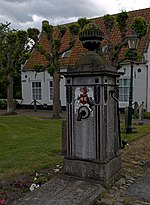Battle of Cadzand
1337 in Europe14th century in the county of FlandersBattles involving FlandersBattles of the Hundred Years' WarConflicts in 1337 ... and 4 more
History of ZeelandHundred Years' War, 1337–1360Naval battles of the Hundred Years' WarSluis

The Battle of Cadzand was an early skirmish of the Hundred Years' War fought in 1337. It consisted of a raid on the Flemish island of Cadzand, designed to provoke a reaction and battle from the local garrison and so improve morale in England and amongst King Edward III's continental allies by providing his army with an easy victory. On 9 November Sir Walter Manny, with the advance troops for Edward III's continental invasion, made an attempt to take the city of Sluys, but was driven off.
Excerpt from the Wikipedia article Battle of Cadzand (License: CC BY-SA 3.0, Authors, Images).Battle of Cadzand
Koolsweg, Sluis
Geographical coordinates (GPS) Address Nearby Places Show on map
Geographical coordinates (GPS)
| Latitude | Longitude |
|---|---|
| N 51.3667 ° | E 3.4 ° |
Address
Koolsweg
Koolsweg
4506 HA Sluis
Zeeland, Netherlands
Open on Google Maps









